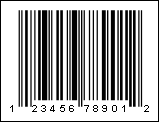EAN-13
The EAN-13 barcode was created based on the UPC-A barcode as an extension of the EAN.UCC system used outside the USA. EAN-13 is the European version of UPC-A. The EAN-13 is a high density, fixed length continuous code. It is used primarily in trade, for labeling goods that will be sold through retail.
Valid symbols: |
0123456789 |
Length: |
fixed, 13 characters |
Check digit: |
one, modulo-10 algorithm |
The structure of EAN-13 barcode is the same as UPC-A. Each barcode character consists of 2 bars and 2 spaces, which may have a width from 1 to 4 modules. The first digit is always placed outside the symbol, additionally the right quiet zone indicator (>) is used to indicate the Quiet Zones that are necessary for barcode scanners to work properly. In addition, the barcode contains three pairs of elongated strokes: the border marks on the left and right of the barcode and the center separator mark. Three combinations of codes are used to self-check the barcode when encoding characters: the left part of the barcode is encoded by the first and second combinations with variable parity, depending on the thirteenth digit; the right part is coded by the third combination with even parity. The check digit is calculated automatically regardless of the input data.
The barcode contains the following data:
![]() 2 (3) digits - country code.
2 (3) digits - country code.
![]() 5 (4) digits - manufacturer code.
5 (4) digits - manufacturer code.
![]() 5 digits - product code.
5 digits - product code.
![]() 1 digit - check digit.
1 digit - check digit.
This way a barcode does not contain any information about characteristics of a product, but only a unique number relating to an entry in the International data base where all information about the particular product is stored. An example barcode in EAN-13 format:

An "EAN-13" barcode.
Information |
The 'human readable' digits at the foot which can be used by operators if the label becomes damaged or will not scan for some reason - "123456789012" is the number encoded in the barcode.
|